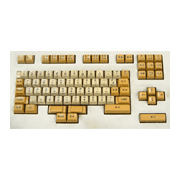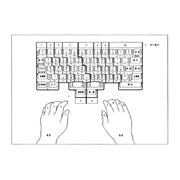This was a keyboard unique to Fujitsu, which was designed to enable easy input of Japanese in a fashion like an English language typewriter. It was developed by Kanda Yasunari of Fujitsu for their first Japanese language word processor, the OASYS 100. The method of input using this "thumb shift keyboard" is outlined below.
(1) The 50 letters of the "kana" syllabary were arranged on 30 keys in 3 rows, like an English language typewriter, with 2 letters being assigned to each key.
(Once the operator learns the key layout, they can input using "touch typing".)
(2) Selection between the 2 letters was done by simultaneously striking a character key together with a "shift key" located at the thumb position.
There were two thumb shift keys, once each for the left and right thumb, and this made the following input possible depending on the simultaneous striking combination of the character key and left/right shift key. Special-purpose "semivoiced sound" keys on the left and right were used to input semivoiced sounds.
| Explanation | Keys struck | Entered letter |
|---|---|---|
| If a character key is struck alone, the character indicated on the bottom of the key is input. |  |
"Ha" |
| If a character key is struck simultaneously with the shift key on the same side, the character indicated on the top of the key is input. |  |
"Mi" |
| If a character key is struck simultaneously with the shift key on the opposite side, the voiced sound is input. |  |
"Ba" |
| If a character key is struck simultaneously with the semivoiced sound key, the semivoiced sound is input. |  |
"Pa" |
The key layout was determined as follows.
(1) Characters with a voiced sound were not placed at the top of keys.
(2) Characters with a high frequency of occurrence were arranged to be easy to strike.
(3) Keys were laid out based on the frequency with which a character occurs next after a given character (transition probability) to minimize the amount of finger movement, and enable alternate use of the left and right thumb.
One character could be input with a single stroke, so fewer keystrokes were needed compared to the alphabetic character input method, and the aforementioned design of the key layout enabled high-speed input of the Japanese language,
This thumb shift keyboard was used for a long time in Japanese word processors from Fujitsu. A thumb shift keyboard was also available as an option for personal computer keyboards.



